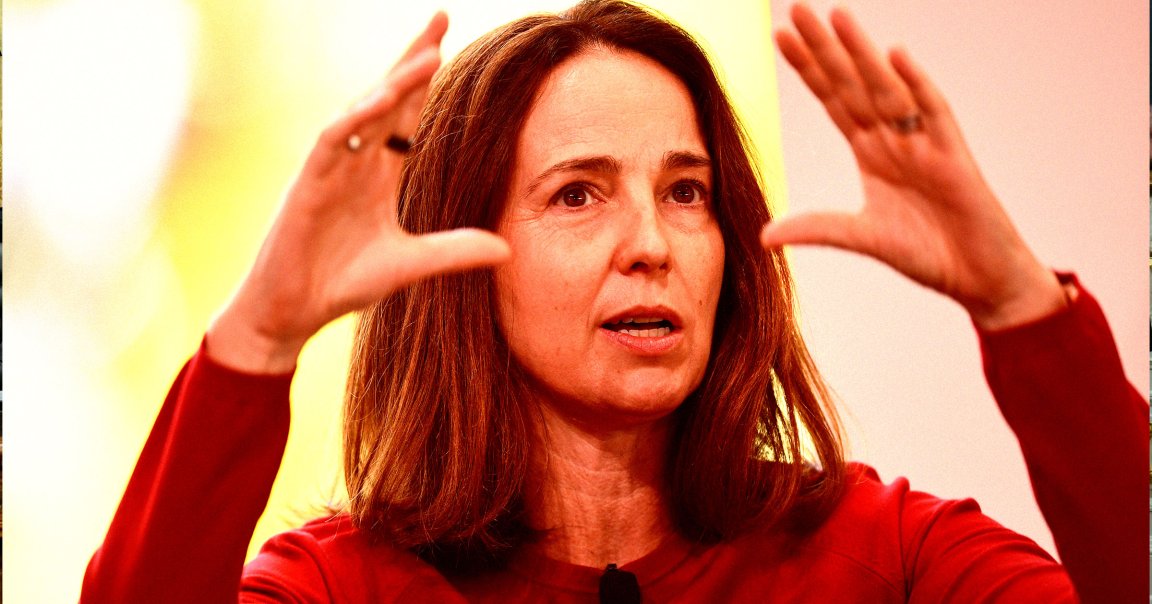
As investors are growing increasingly concerned over an AI bubble, triggering a major tech selloff earlier this week, OpenAI is still in full-steam-ahead mode.
During the Wall Street Journal‘s Tech Live conference on Wednesday, the ChatGPT maker’s chief financial officer Sarah Friar revealed that the company has no plans of going public, contradicting rumors.
“IPO is not on the cards right now,” she said at the event. “We are continuing to get the company into a state of constantly stepping up into the scale we are at, so I don’t want to get wrapped around an IPO axle.”
And as the company eschews a public listing, Friar said that it’s looking to create an “ecosystem of banks, private equity, maybe even governmental” so it can take on even more debt.
She hinted that the US government could “backstop the guarantee that allows the financing to happen,” but didn’t elaborate any further on how such an arrangement would work.
Her comments were bound to raise plenty of eyebrows on Wall Street. OpenAI has been losing a staggering amount of money and has yet to prove it can deliver on a return on investment. Does that really make it a prime candidate for governmental backing? Could Briar be implying that the government should bail OpenAI out in case things go south?
It didn’t take long for Friar to take to LinkedIn and renege on her previous statement, saying that “OpenAI is not seeking a government backstop for our infrastructure commitments.”
“I used the word ‘backstop’ and it muddied the point,” she added.
Even CEO Sam Altman intervened on X-formerly-Twitter in an apparent attempt to calm spooked investors, saying that “we do not have or want government guarantees for OpenAI data centers.”
“We believe that governments should not pick winners or losers, and that taxpayers should not bail out companies that make bad business decisions or otherwise lose in the market,” he wrote, arguing that it makes “a lot of sense” for the government to have its own “strategic national reserve of computing power.”
Despite OpenAI’s immediate 180 following Friar’s foot-in-mouth blunder, the Trump administration has already shown that it’s willing to go far in its efforts to facilitate AI deals and even clear the way for infrastructure buildouts by loosening environmental regulations.
For now, OpenAI doesn’t seem overly concerned about the billions of dollars it’s suspected to be bleeding every quarter. A recent analysis by The Register suggested that it lost $11.5 billion last quarter.
The firm is planning to spend upwards of $1 trillion over the next five years to build out AI infrastructure, capital expenditure that would require the company to rapidly scale up its revenue as well to be able to make payments on a growing mountain of debt.
That could be far easier said than done. OpenAI CEO Sam Altman recently boasted that its blockbuster product, ChatGPT, has 800 million users — except that only a mere five percent are willing to pay for a subscription, forcing the company to subsidize hundreds of millions of free users by taking on the expense of additional compute. Worse yet, recent figures suggest ChatGPT revenue is starting to plateau in Europe and elsewhere, indicating waning demand.
Briar said this week that the company is looking for new ways to grow sales outside of its ChatGPT, claiming that enterprise sales make up 40 percent of revenue, compared to just 30 percent at the beginning of 2025.
Either way, she said that she wasn’t “overly focused on a break-even moment today,” saying that she has a “healthy enough margin structure that I could do that by pulling back on investment.”
That’s despite recently completing the restructuring of its for-profit arm, in a move that critics say has largely subjugated its original nonprofit roots.
Finances have clearly been a sore point for OpenAI executives. Altman similarly said that he’s not concerned about making money. When he was recently challenged by OpenAI investor and podcaster Brad Gerstner about how a “company with $13 billion in revenues” can “make $1.4 trillion of spend commitments,” he responded forcefully, implying Gerstner should sell his shares if he doesn’t believe in the company’s outlook.
Given the recent slip in confidence among investors, the cracks in the immense hype surrounding AI are starting to show. Where that leaves OpenAI’s planned spending spree remains to be seen. The company certainly has a lot to prove, especially when it comes to its business fundamentals.
In his tweet responding to Friar’s comments, Altman once again attempted to sell investors on an extremely bright future ahead, turning the hype dial up to 11 once more.
“We expect to end this year above $20 billion in annualized revenue run rate and grow to hundreds of billion by 2030,” he wrote. “We are quite excited about our upcoming enterprise offering for example, and there are categories like new consumer devices and robotics that we also expect to be very significant.”
During this week’s conference, tellingly, Briar lamented that there wasn’t enough excitement about AI — despite the enormous amount of hype and tens of billions of dollars in investment.
“I don’t think there’s enough exuberance about AI, when I think about the actual practical implications and what it can do for individuals,” she said. “We should keep running at it.”
If things were to go south, Altman said that he’s willing to take the blame instead of asking for a government bailout.
“We plan to be a wildly successful company, but if we get it wrong, that’s on us,” he wrote.
More on OpenAI: The Amount of Money OpenAI Lost Last Quarter Will Make You Choke on Your Slurpee